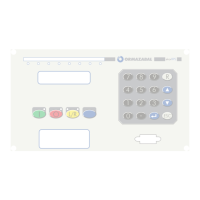IG-150-EN version 04; 03/10/16
119
General instructions
ekor.rps
Automation functions
2. Synchronism permission. It is given permission if
during a programmable time, the following conditions
are simultaneously fullled:
a. Difference between V
A
and V
B
lower that the programmed
value.
b. Difference in phase angles lower than the programmed
value.
c. Difference in frequencies lower than the programmed
value.
Each one of these three conditions can be enabled or not. If it
is not, it gives permission.
If there is a relay programmed as “closure permission”, it gets
activated when the described conditions are fullled; this way
any closure can be locked if that relay is used as locking of the
manual command.
We stress that this permission is referred only to the
synchrocheck function; so she is only the one that controls
the “closure permission” relay. It must not be confused with
“closure”, which is a relay controlled by closure commands
(digital input or command).
The function does not take into account the breaker status,
that is, it can give closure.
As control signals we can nd the following ones: Voltage
dierence, frequency and angle and Syncrocheck locked (by
input, setting).
5.5.2. Settings
Setting Min Max Step Notes
Enable
YES/NO
Minimum voltage in side A [V]
10 200 1
Minimum voltage in side B [V]
10 200 1
Undervolt. permission enable “No A, No B”
YES/NO
Undervolt. permission enable “No A, B”
YES/NO
Undervolt. permission enable. “No B, A”
YES/NO
Voltage dierence condit. enable
YES/NO
Voltage dierence [V]
2 90 1
Frequency dierence condit. Enable
YES/NO
Frequency dierence [Hz]
0.05 2 0.01
Angle dierence condit. Enable
YES/NO
Angle dierence [º]
5 50 1
Conditions fullling time [s]
0 100 1
Table 5.3. Settings
5.6. Close locking with presence or absence of voltage
Inhibition by voltage presence on the line side. It tries to
lock the closing if there is voltage on the line side. So that,
the FW version presents the following changes:
1. It adds a condition to the synchronism, so that, if the
units that look at the parameter dierences (module,
angle and frequency) are disabled the undervoltage
unit criterion is taken as a decision to allow or not the
closing.
Example: Enable the synchronism and set only permission for
“Yes side A-No side B” and “No side A-No side B” disabling the
permissions by dierence of module, angle and frequency.
In that situation the undervoltage criterion prevails over the
dierences of shape, which does not allow the closing, if there
is voltage on side B.
2. It adds new signals of presence and absence of voltage
on side A and on side B and these signals can be taken
to the recloser locking signal through a logic. The added
signals are the followin:
a. Voltage presence on side A
b. Voltage presence on side B
c. Voltage absence on side A
d. Voltage absence on side B
Example: If side A voltage is lower than the absence (used
in the synchronism) side A voltage absence signal will be
activated; if the presence setting is exceeded, the absence
one is deactivated and the presence one is activated.

